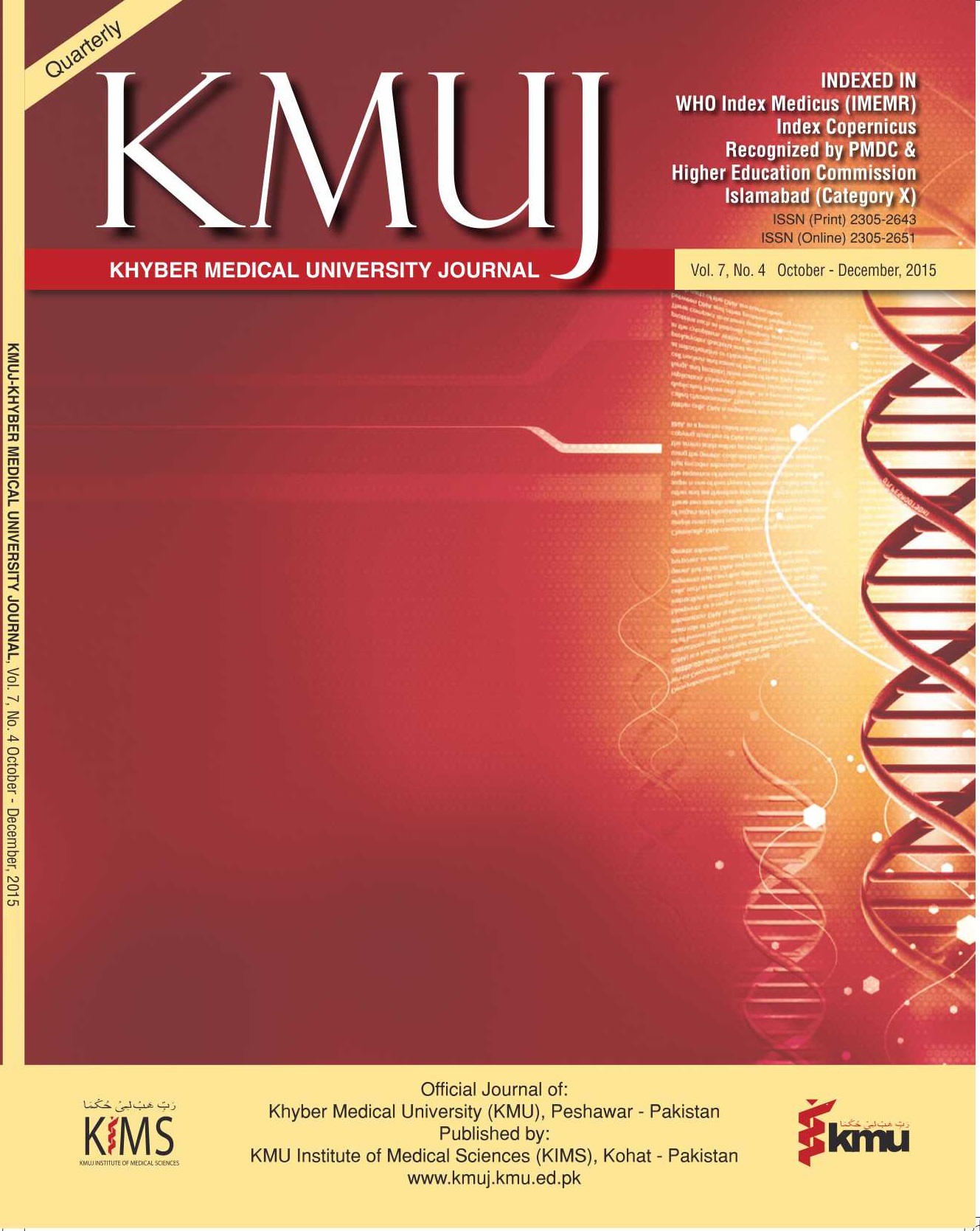Molecular Genetic Analysis of Limb Girdle Muscular Dystrophy 2A (LGMD2A) in two consanguineous Pakistani families
Main Article Content
Abstract
Objectives: To investigate molecular pathogenesis of the disease and to significantly improve diagnosis and understanding of muscular dystrophy in Pakistani population.
Methods: This study was carried out at the department of Biochemistry, Quaid-I-Azam University Islamabad on two families affected with limb girdle muscular dystrophies (LGMD). Duration of the study was one year. Blood samples were collected from three normal and three affected individuals of the family A, eight affected individuals and four normal individuals of the family B for genetic analysis. Technique of homozygosity mapping was used to track the gene responsible for autosomal recessive LGMD2A in two families. The gene CAPN3 was sequenced in two families using Sanger sequencing approach.
Results: Genotyping data and haplotypes analysis showed that all affected individuals of family A (V-4, V-6, V-7) and family B (IV-1, IV-2, IV-4, IV-5, IV-6, IV-7, IV-10, IV-11) were homozygous while all normal individuals of family A (III-1, IV-1, V-5) and family B (III-4, III-5, IV-8, IV-12) were heterozygous, thus establishing linkage of the family A to CAPN3 gene on chromosome 15q15.1-q21.1. Subsequently, sequencing of all the 24 exons and exon-introns boundaries of CAPN3 genes showed no disease causing DNA sequence variant.
Conclusion: No disease causing DNA sequence variant was found in these exons suggesting the presence of mutation in the regulatory sequences or any other genes present in this region.
Key words: Cytogenetic Analysis (MeSH), Limb-girdle muscular dystrophy type 2A (MeSH), LGMD2A (MeSH), Consanguinity (MeSH), Pakistan (MeSH)
Article Details
Work published in KMUJ is licensed under a
Creative Commons Attribution 4.0 License
Authors are permitted and encouraged to post their work online (e.g., in institutional repositories or on their website) prior to and during the submission process, as it can lead to productive exchanges, as well as earlier and greater citation of published work.
(e.g., in institutional repositories or on their website) prior to and during the submission process, as it can lead to productive exchanges, as well as earlier and greater citation of published work.
References
REFERENCES
Zatz M, de Paula F, Starling A, Vainzof M. The 10 autosomal recessive limb girdle muscular dystrophies. Neuromuscul Disord 2003; 13: 532-44.
Nigro V, Aurino S, Piluso G. Limb girdle muscular dystrophies: update on genetic diagnosis and therapeutic approaches. Curr Opin neurol 2011; 24(5):429-36.
Moore SA, Shilling CJ, Westra S, Wall C, Wicklund MP, Stolle C, et al. Limb girdle muscular dystrophy in the United States. J Neuropathol Exp Neurol 2006; 65(10): 995-1003.
Fanin M, Nascimbeni AC, Fulizio L, Trevisan CP, Meznaric-Petrusa M, Angelini C. Loss of calpain-3 autocatalytic activity in LGMD2A patients with normal protein expression. Am J Pathol 2003; 163(5):1929-36.
Mercuri E, Bushby K, Ricci E, Birchall D, Pane M, Kinali M, et al. Muscle MRI findings in patients with limb girdle muscular dystrophy with calpain 3 deficiency (LGMD2A) and early contractures. Neuromuscul Disord 2005; 15(2):164-71.
Zatz M, Vainzof M, Passos-Bueno MR. Limb-girdle muscular dystrophy: one gene with different phenotypes, one phenotype with different genes. Curr Opin Neurol 2000;13: 511-17.
M Vainzof, F de Paula, A M Tsanaclis, M Zatz, The effect of calpain 3 deficiency on the pattern of muscle degeneration in the earliest stages of LGMD2A. J Clin Pathol 2003;56:624–26.
Piluso G, Politano L, Aurino S, Fanin M, Ricci E, Ventriglia VM, et al. Extensive scanning of the calpain-3 gene broadens the spectrum of LGMD2A phenotypes. J Med Genet 2005; 42(9):686-93.
Kramerova I, Beckmann JS, Spencer MJ. Molecular and cellular basis of calpainopathy (limb girdle muscular dystrophy type 2A). Biochim Biophys Acta 2007; 1772: 128-44.
Richard I, Broux O, Allamand V, Fougerousse F, Chiannilkulchai N, Bourg N, et al. Mutations in the proteolytic enzyme calpain 3 cause limb girdle muscular dystrophy type 2A. Cell 1995; 81: 27-40.
Bennett RL, Steinhaus KA, Uhrich SB, O’Sullivan CK, Resta RG, Lochner-Doyle D et al. Recommendations for standardized human pedigree nomenclature. Pedigree standardization task force of the national society of genetic counselors. Am J Hum Genet 1995; 56: 745-52.
Matise TC, Chen F, Chen W, De La Vega FM, Hansen M, He C, et al. A second-generation combined linkage physical map of the human genome. Genome Res. 2007 Dec;17(12):1783-6. Epub 2007 Nov 7.
Milic A, Daniele N, Lochmuller H, Mora M, Comi GP, Moggio M, et al. A third of LGMD2A biopsies have normal calpain 3 proteolytic activity as determined by an in vitro assay. Neuromuscul Disord 2007; 17: 148-56.
Zatz M, de Paula F, Starling A, Vainzof M. The 10 autosomal recessive limb-girdle muscular dystrophies. Neuromuscul Disord 2003; 13: 532-44.
Guglieri M, Magri F, D'Angelo MG, Prelle A, Morandi L, Rodolico C, et al. Clinical, molecular, and protein correlations in a large sample of genetically diagnosed Italian limb girdle muscular dystrophy patients. Hum Mutat 2008; 29: 258-66.
Lo HP, Cooper ST, Evesson FJ, Seto JT, Chiotis M, Tay V, et al. Limb-girdle muscular dystrophy: Diagnostic evaluation, frequency and clues to pathogenesis. Neuromuscul Disord 2008; 18: 34-44.
Sveen ML, Schwartz M, Vissing J. High prevalence and phenotype-genotype correlations of limb girdle muscular dystrophy type 2I in Denmark. Ann Neurol 2006; 59: 808-15.
Moore SA, Shilling CJ, Westra S, Wall C, Wicklund MP, Stolle C, et al. Limb-girdle muscular dystrophy in the United States. J Neuropathol Exp Neurol 2006; 65: 995-1003.
